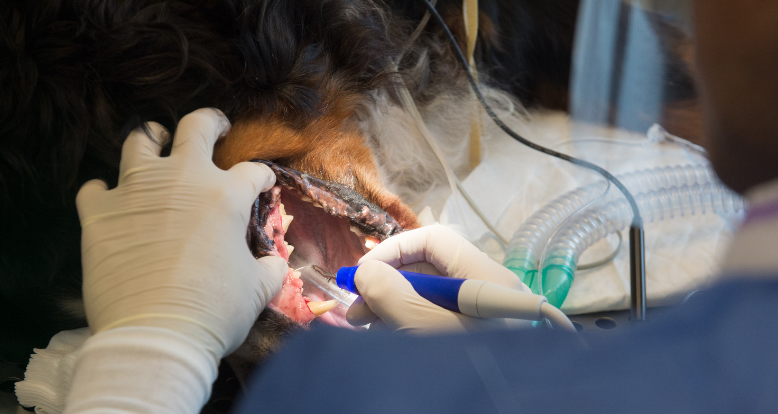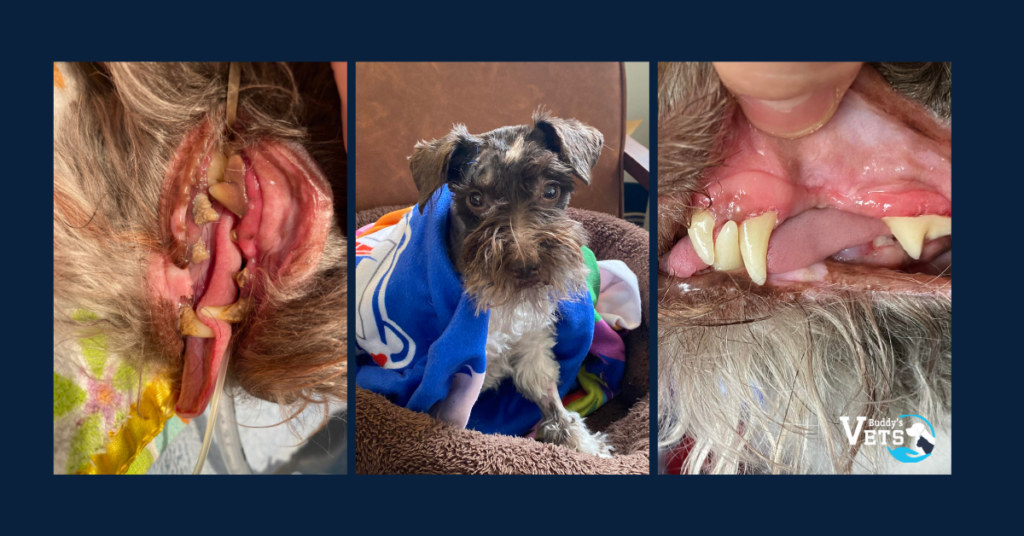Don’t Neglect Your Pet’s Teeth – The Importance of Pet Dentals
Can you imagine not brushing your teeth for a day or two or even a week? Now imagine not brushing your teeth longer, say years? You probably can’t, but that’s usually what happens for our pet’s teeth. It’s easy to overlook the significance of brushing their teeth. Your pet’s dental health, when neglected, can lead to a variety of dental issues, which also affects their overall well-being. In this blog, we’ll talk about the importance of pet dentals, shed some light on what truly happens when your pet’s teeth are cleaned, and what steps you can take at home to help keep your pet’s teeth healthy.
Your Pet’s Dental Health is Important
Just as it can be for people, untreated poor dental health can lead to a variety of health issues. The health of your pet’s teeth is reflected in their overall health. For example, plaque on their teeth, if left untreated, can lead to organ issues. Bad breath, often an early sign of dental disease, may contribute to heart, kidney, and liver complications.
Prioritizing your pet’s dental health is crucial to prevent these issues and quite simply comes down to your pet’s quality of life. For another resource on the importance of your pet’s dental health, see this article here from the AVMA.
Dental Disease
What is dental disease? Dental disease is infection and inflammation of the tissues surrounding the tooth and can occur in the gums, root structure and jaws. But, just like in people, you may not always be able to visually see dental disease.
A lot of our pets have dental disease without us knowing. Dental disease is one of the most common conditions we see at Buddy’s Vets. It occurs in over 80% of dogs over three years old and in over 50% of cats over 3 years. The question then is how can you know if your pet has dental disease?
Signs your pet has dental disease may include:
- Bad breath
- Trouble eating or favoring one side of their mouth when eating
- Mouth pain
- Pawing at mouth
- Decreased appetite
- Bleeding or inflamed gums
- Discolored teeth (brown or yellow)
- Loose or missing teeth
- Weight loss
- Bloody saliva
- Excessive drooling
- Blood in water bowl or on chew toys
Pets are notorious for hiding or masking their pain. They also can’t tell us when they have a toothache or a bad taste in their mouth. It’s why it’s so important that if you notice any of these symptoms in your pet, that you give your veterinarian a call.
Pet Dentals at Buddy’s Vets

At Buddy’s Vets, we recommend dental cleaning, or COHAT as we call them, for your pet at least once a year. COHAT stands for Comprehensive Oral Health Assessment and Treatment. Everything that happens at the dentist for us is also happening for your pets, with the exception that pet dentals are always done under anesthesia.
Why anesthesia?
Why always under anesthesia? There is a lot of pushback for this, as it inevitably increases the cost. First and foremost, pet dentals are always done under anesthesia because it’s the standard of care and practice used across veterinary medicine. It’s also been deemed malpractice to do unanesthetized dental cleanings on animals. The AAHA says that doing anesthesia can be both physically and mentally harmful to your pet.
Buddy’s Vets follows the highest standard of care when it comes to our anesthesia protocol. We also use gas anesthesia, which helps them come out of anesthesia quicker without any major side effects.
In addition, your pet will get:
- Pre-anesthetic blood work regardless of age or when it was last done. We need to know if your pet is healthy and safe to go under anesthesia.
- A customized anesthesia protocol just for them to account for any underlying diseases or particular needs.
- An IV catheter so we have control should anything go amiss that we need to give extra medicine. We also use this to administer fluids to keep them hydrated.
- Warm fluids throughout the whole process, with warm being the crucial part. We want to keep their body temperature stable.
- A heated table and heated blankets, again to keep them warm and comfortable the entire time.
- An endotracheal tube to make sure they stay well oxygenated and to protect their airways.
- Monitoring the entire time by a highly qualified technician who monitors everything from their heart rate, to blood pressure, to oxygen saturation, to carbon dioxide output, and how much they are breathing in a minute.
Your pet is in the best hands at Buddy’s Vets while they are under anesthesia for their dental cleaning.
What happens during your pet’s dental visit at Buddy’s Vets?
During your pet’s dental cleaning, a lot happens, which is also why it’s necessary for them to be under anesthesia. With their cleaning, your pet gets full mouth digital radiographs (aka x-rays) taken, their teeth scaled and polished, and the doctor does a full oral exam where every single tooth is charted, noted, and measured.
In the exam, we may also notice that your pet needs to have some teeth extracted. Tooth extractions are done for a variety of reasons such as broken teeth or infections. We also do everything possible to warn you that depending on your pet’s teeth, they may lose some teeth, but we can’t know exactly if any or how many teeth will need to be extracted. It’s also why we take radiographs, because everything may look good on the surface of the tooth, but radiographs tell the whole story. We also try to communicate with you before your pet’s cleaning that extractions are possible and if things are worse than initially thought, we will do our best to communicate during the procedure. Ultimately, we make the best decision for your pet based on what the radiographs dictate.
After picking up your pet following their dental cleaning, we will furnish you with essential care instructions, particularly if any teeth extractions were performed.
Home Dental Tips for Your Pet
While we recommend annual teeth cleanings for your pet, we also highly encourage at-home dental care to maintain their dental health. There are things you can do at-home to keep your pet’s teeth healthy in between cleanings.
The biggest thing is removing the biofilm. The biofilm that gathers on their teeth everyday is like a magnet for more bacteria, plaque and tartar. You can remove the biofilm by wrapping your finger in a washcloth or use gauze and wipe the outside of all the teeth. If your pet will let you, use a toothbrush, which will allow for more mechanical breakdown of the biofilm.
In addition, there are products you can use for your pet’s teeth at home such as enzymatic toothpaste, dental food and treats. When looking at dental food or treats, look for the VOHC seal of approval or if you’re unsure, give us a call or your local veterinarian.
And remember that something is better than nothing. Even if you only brush your pet’s teeth one day a week on Sunday, that is amazing. Keep up the good work!
Success Stories
At Buddy’s Vets, we love to see the transformation of your pet’s teeth after a dental cleaning. Below you can see Sophie’s amazing before and after from her cleaning with us.

Don’t Neglect Your Pet’s Teeth
At the end of the day, as veterinarians, we aren’t trying to “sell” you when we talk to you about dental cleanings, instead we are offering an imperative service for your pet. Dental care for pets is not just a routine procedure; it’s a crucial aspect of enhancing their quality of life and it’s why Buddy’s Vets is so passionate about them. It’s our hope that we’ve provided you with valuable information about the importance of pet dentals and answered any questions you may have had. Whether your pet hasn’t had their teeth cleaned in a while, or ever, we would love to be there for your pet’s dental needs. Reach out to us today to talk about all of your pet’s dental needs.
